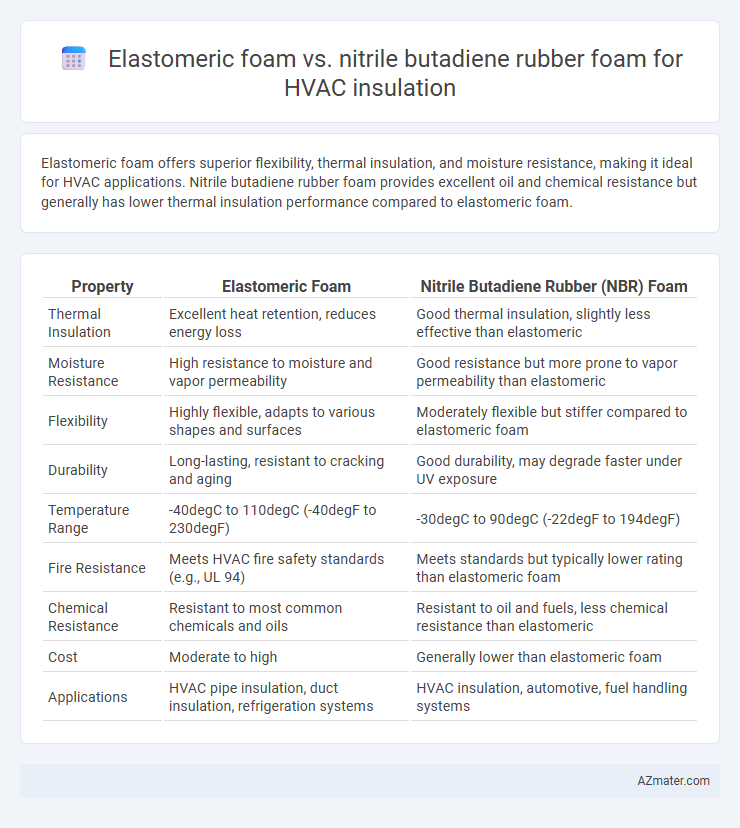Elastomeric foam offers superior flexibility, thermal insulation, and moisture resistance, making it ideal for HVAC applications. Nitrile butadiene rubber foam provides excellent oil and chemical resistance but generally has lower thermal insulation performance compared to elastomeric foam.
Table of Comparison
| Property | Elastomeric Foam | Nitrile Butadiene Rubber (NBR) Foam |
|---|---|---|
| Thermal Insulation | Excellent heat retention, reduces energy loss | Good thermal insulation, slightly less effective than elastomeric |
| Moisture Resistance | High resistance to moisture and vapor permeability | Good resistance but more prone to vapor permeability than elastomeric |
| Flexibility | Highly flexible, adapts to various shapes and surfaces | Moderately flexible but stiffer compared to elastomeric foam |
| Durability | Long-lasting, resistant to cracking and aging | Good durability, may degrade faster under UV exposure |
| Temperature Range | -40degC to 110degC (-40degF to 230degF) | -30degC to 90degC (-22degF to 194degF) |
| Fire Resistance | Meets HVAC fire safety standards (e.g., UL 94) | Meets standards but typically lower rating than elastomeric foam |
| Chemical Resistance | Resistant to most common chemicals and oils | Resistant to oil and fuels, less chemical resistance than elastomeric |
| Cost | Moderate to high | Generally lower than elastomeric foam |
| Applications | HVAC pipe insulation, duct insulation, refrigeration systems | HVAC insulation, automotive, fuel handling systems |
Introduction to HVAC Insulation Materials
Elastomeric foam and nitrile butadiene rubber (NBR) foam are widely used HVAC insulation materials designed to minimize heat transfer and prevent condensation. Elastomeric foam offers superior flexibility, closed-cell structure, and excellent resistance to moisture, ozone, and UV degradation, making it ideal for HVAC systems. NBR foam provides enhanced chemical resistance and durability, particularly against oils and fuels, making it suitable for specialized HVAC environments requiring robust protection.
What is Elastomeric Foam?
Elastomeric foam is a flexible, closed-cell insulation material primarily composed of synthetic rubber, known for its excellent thermal resistance and moisture impermeability in HVAC systems. This foam offers superior sound absorption and durability compared to traditional materials, making it ideal for reducing energy loss and preventing condensation. Elastomeric foam's resistance to mold, mildew, and ozone enhances its longevity and efficiency in maintaining optimal indoor air quality.
What is Nitrile Butadiene Rubber (NBR) Foam?
Nitrile Butadiene Rubber (NBR) foam is a synthetic rubber material widely used in HVAC insulation due to its excellent resistance to oil, fuel, and chemicals, making it ideal for industrial and commercial applications. Unlike elastomeric foam, which emphasizes thermal insulation and flexibility, NBR foam offers superior durability and mechanical strength while maintaining good thermal conductivity and sound absorption properties. Its closed-cell structure enhances moisture resistance, providing effective protection against condensation in HVAC systems.
Key Physical Properties Comparison
Elastomeric foam offers superior flexibility and closed-cell structure with thermal conductivity typically around 0.03 W/m*K, making it highly effective for HVAC insulation against heat transfer and moisture absorption. Nitrile butadiene rubber (NBR) foam provides excellent oil and chemical resistance with slightly lower compression set performance but comparable thermal insulation properties, generally ranging from 0.035 to 0.04 W/m*K. Both materials exhibit good durability; however, elastomeric foam usually outperforms in UV resistance and long-term flexibility under temperature fluctuations.
Thermal Insulation Performance
Elastomeric foam offers superior thermal insulation performance in HVAC applications due to its closed-cell structure, which effectively reduces heat transfer and resists moisture absorption. Nitrile butadiene rubber (NBR) foam, while flexible and resistant to oils, generally exhibits higher thermal conductivity, resulting in lower insulation efficiency compared to elastomeric foam. Selecting elastomeric foam enhances energy efficiency by maintaining consistent temperature control and minimizing heat loss in HVAC systems.
Moisture and Vapor Resistance
Elastomeric foam offers superior moisture and vapor resistance due to its closed-cell structure, effectively preventing condensation and mold growth in HVAC systems. Nitrile butadiene rubber (NBR) foam, while flexible and chemically resistant, typically has a more open-cell structure that allows higher moisture permeability, reducing its effectiveness in vapor barrier applications. For HVAC insulation, elastomeric foam remains the preferred choice to ensure long-term protection against moisture intrusion and vapor diffusion.
Installation and Flexibility
Elastomeric foam offers superior flexibility and ease of installation due to its closed-cell structure and lightweight composition, allowing it to easily conform to irregular HVAC surfaces and reduce installation time. Nitrile butadiene rubber (NBR) foam provides excellent chemical resistance and durability but tends to be less flexible, often requiring more precise fitting and additional labor during installation. The choice between elastomeric foam and NBR foam impacts project efficiency, with elastomeric foam generally preferred for quick, adaptable HVAC insulation applications that demand tight seals around complex geometries.
Cost Considerations
Elastomeric foam generally offers a lower initial cost compared to nitrile butadiene rubber (NBR) foam, making it a budget-friendly choice for HVAC insulation projects. However, NBR foam provides superior chemical resistance and durability, potentially reducing long-term replacement and maintenance expenses. Evaluating total cost of ownership reveals elastomeric foam is cost-effective for standard applications, while NBR foam is more economical over time in harsh environments.
Applications in HVAC Systems
Elastomeric foam is widely used in HVAC systems for pipe insulation, ductwork, and refrigeration lines due to its superior thermal resistance, flexibility, and moisture resistance. Nitrile butadiene rubber (NBR) foam offers excellent oil and chemical resistance, making it ideal for HVAC components exposed to oil vapors or aggressive environments. Both materials provide effective insulation but selecting elastomeric foam enhances energy efficiency and condensation control, whereas NBR foam ensures durability in harsher operational conditions.
Choosing the Right Foam for Your HVAC Needs
Elastomeric foam offers superior flexibility and excellent resistance to moisture and mold, making it ideal for HVAC insulation in humid environments. Nitrile butadiene rubber (NBR) foam provides exceptional chemical resistance and durability, suitable for HVAC systems exposed to oils and harsh industrial conditions. Selecting the right foam depends on factors like environmental exposure, thermal performance requirements, and budget constraints.

Infographic: Elastomeric foam vs Nitrile butadiene rubber foam for HVAC insulation
 azmater.com
azmater.com